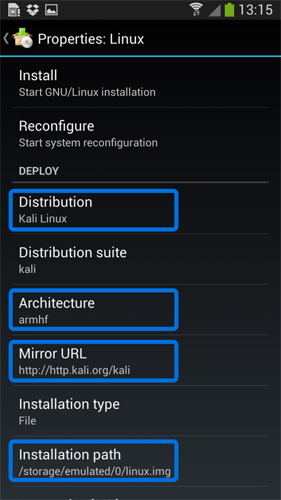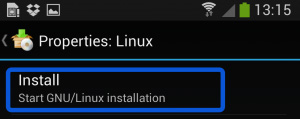How to install Kali Linux on Android using Linux Deploy
Making Kali Linux run on ARM hardware has been a major goal and so far the company has built original images for Samsung Chromebook, Odroid U2, Raspberry Pi, RK3306, Galaxy Note 10.1, CuBox, Efika MX and BeagleBone Black. However this does not mean that you cannot install Kali Linux in a chroot on most modern devices running Android . In fact, Linux Deploy developers have made this extremely easy to install Linux distributions in a chroot environment using a simple GUI builder.
- Instructions for installing Linux desktop environment on Android device
Conditions :
- A device running Android 2.1 and above and has been rooted.
- The device has at least 5 GB of free space on internal memory or external memory.
- Wireless internet connection, fast.
- Patiently wait for the distribution to bootstrap from the network.
- Download : Linux Deploy
Linux Deploy configuration for Kali

In fact there is very little work to do to install Potassium. Select Kali Linux in the " Distribution " tab. Here, you can choose the architecture, authenticate the Kali mirror, set the type of installation and location on the Android device, etc. In general, the default Linux settings Deploy are very good so you don't need to change what.
Build image Kali

When satisfied with all settings, pressing the " Install " button will start bootstrap Kali Linux directly from the repository. Depending on the speed of Internet connection, this process may take some time. Once complete, you will have a basic installation of Kali Linux (without tools) at a minimum.
Starting Potassium has been chroot
When the installation process is complete, Linux Deploy will automatically mount and download the chroot Kali Linux image. This will make services such as SSH and VNC easier to access remotely. All this is done automatically by clicking the " Start " button . You should see Linux Deploy set the image with the output similar to the following:

At this stage, Linux Deploy will launch a VNC server and SSH inside the Potassium image has been chrooted. You can connect to a remote Kali session with the IP address assigned to the Android device (10.0.0.10 in this example).
Log on to Potassium has been chroot
Now you can use the SSH or VNC client to access the Kali instance. VNC password is " changeme " and SSH information is " android " for user name (configured via Linux Deploy) and " changeme " as password.
muts@slim:~$ ssh android@10.0.0.10
android@10.0.0.10 password:
Linux localhost 3.4.5-447845 #1 SMP PREEMPT Fri Apr 12 17:22:34 KST 2013 armv7l
Kali GNU/Linux 1.0 [running on Android via Linux Deploy]
android@localhost:~$ sudo su
root@localhost:/home/android # df
Filesystem 1K-blocks Used Available Use% Mounted on
/dev/loop3 4180944 667268 3304012 17% /
tmpfs 952708 80 952628 1% /dev
tmpfs 952708 0 952708 0% /dev/shm
root@localhost:/home/android #
root@localhost:/home/android # apt-get update
Hit http://http.kali.org kali Release.gpg
Hit http://http.kali.org kali Release
Hit http://http.kali.org kali/main Sources
Hit http://http.kali.org kali/contrib Sources
Hit http://http.kali.org kali/non-free Sources
Hit http://http.kali.org kali/main armel Packages
Hit http://http.kali.org kali/contrib armel Packages
Hit http://http.kali.org kali/non-free armel Packages
Ign http://http.kali.org kali/contrib Translation-en_US
Ign http://http.kali.org kali/contrib Translation-en
Ign http://http.kali.org kali/main Translation-en_US
Ign http://http.kali.org kali/main Translation-en
Ign http://http.kali.org kali/non-free Translation-en_US
Ign http://http.kali.org kali/non-free Translation-en
Reading package lists. Done
root@localhost:/home/android #
Image size
If not changed, Linux Deploy will automatically set the image size to around 4GB for the "bare" Kali installation. If you want to install more Kali tools, you can use a larger image size, configured via the Linux Deploy settings.
Local VNC connection
You may need to try a few VNC clients to get the best results. Although controlling Kali through a local VNC client is not the most convenient, it is still possible. However, most people often use SSH'ing in this case.

I wish you all success!
You should read it
- 17 lightweight Linux distributions bring new life to old computers
- 3 Linux mobile operating systems you can install today
- How to install Deepin Linux
- Instructions for installing basic Arch Linux
- How to use the Linux command line on Android with Termux
- What is Puppy Linux? Everything you need to know about Puppy Linux
- 5 ways to make Linux desktops look great
- How to Install Linux Mint Operating System
May be interested
- Kali Linux 2019.1 was officially released
 yes, a great news for those who like dabble and cyber security experts operating in the field of penetration monitoring.
yes, a great news for those who like dabble and cyber security experts operating in the field of penetration monitoring. - Things you need to know about Kali Linux Image
 to run 'live' potassium from a usb drive on a standard windows and apple computer, you'll need a bootable linux kali iso image, in 32-bit or 64-bit format.
to run 'live' potassium from a usb drive on a standard windows and apple computer, you'll need a bootable linux kali iso image, in 32-bit or 64-bit format. - How to update Kali Linux and fix errors when updating
 kali linux's excellent penetration testing system like any other system in the world needs to be updated. but most updates are not developed by the kali linux founding team but are created by programmers themselves.
kali linux's excellent penetration testing system like any other system in the world needs to be updated. but most updates are not developed by the kali linux founding team but are created by programmers themselves. - How to encrypt LVM partitions when installing Kali Linux
 sometimes, we have sensitive data and want to encrypt using the entire drive encryption. with kali installer, you can start installing lvm partition encryption on both the hard drive or usb drive. the installation procedure is very similar to the normal kali linux installation, except to choose an encrypted lvm partition during installation.
sometimes, we have sensitive data and want to encrypt using the entire drive encryption. with kali installer, you can start installing lvm partition encryption on both the hard drive or usb drive. the installation procedure is very similar to the normal kali linux installation, except to choose an encrypted lvm partition during installation. - How to Install Nessus on Kali Linux
 vulnerability scanning is an essential aspect of modern cybersecurity, and nessus is a well-known tool that provides a comprehensive solution for vulnerability assessment.
vulnerability scanning is an essential aspect of modern cybersecurity, and nessus is a well-known tool that provides a comprehensive solution for vulnerability assessment. - Kali Linux is available on the Windows Store but is flagged by Windows Defender
 kali linux is available on windows 10 store for use with windows subsystem for linux, but it cannot bypass windows defender.
kali linux is available on windows 10 store for use with windows subsystem for linux, but it cannot bypass windows defender. - Instructions for installing Kali Linux on Windows 10 are easier than ever
 you can download and install kali linux directly from the microsoft app store on windows 10 as easily as installing any other application. this is a guide to installing kali linux on windows 10, without usb boot, virtualization software at all.
you can download and install kali linux directly from the microsoft app store on windows 10 as easily as installing any other application. this is a guide to installing kali linux on windows 10, without usb boot, virtualization software at all. - Introducing Kali Linux operating system
 kali linux is a debian-based linux distribution aimed at penetration testing and advanced security testing.
kali linux is a debian-based linux distribution aimed at penetration testing and advanced security testing. - Kali Linux installation instructions on VMware virtual machine in the most detailed
 full guide on how to install kali linux on a vmware virtual computer, detailed to the teeth. how to install kali linux operating system on a virtual computer is extremely simple
full guide on how to install kali linux on a vmware virtual computer, detailed to the teeth. how to install kali linux operating system on a virtual computer is extremely simple - How to install Kali Linux dual boot on macOS
 since the release of kali linux 1.0.8, kali linux supports adding efi. this additional feature simplifies the process of installing and running potassium on various apple macbook air, pro and retina models. modeling the device will determine the level of success when users experience with newer devices. refind preinstallation can also increase the success rate on older devices. this tutorial will show you dual osx booting with kali linux using refind and encryption options
since the release of kali linux 1.0.8, kali linux supports adding efi. this additional feature simplifies the process of installing and running potassium on various apple macbook air, pro and retina models. modeling the device will determine the level of success when users experience with newer devices. refind preinstallation can also increase the success rate on older devices. this tutorial will show you dual osx booting with kali linux using refind and encryption options










 How to get money back when buying apps on Android
How to get money back when buying apps on Android How to create ringtones from Zing MP3 Android
How to create ringtones from Zing MP3 Android How to create Facebook sticker with Zamoji application
How to create Facebook sticker with Zamoji application How to name the Son according to feng shui five elements
How to name the Son according to feng shui five elements How to stop receiving continuous 'Apps running in background' notifications on Android 8.0 Oreo
How to stop receiving continuous 'Apps running in background' notifications on Android 8.0 Oreo Redeem feature Night Light for Android 8.0 Oreo on Nexus
Redeem feature Night Light for Android 8.0 Oreo on Nexus